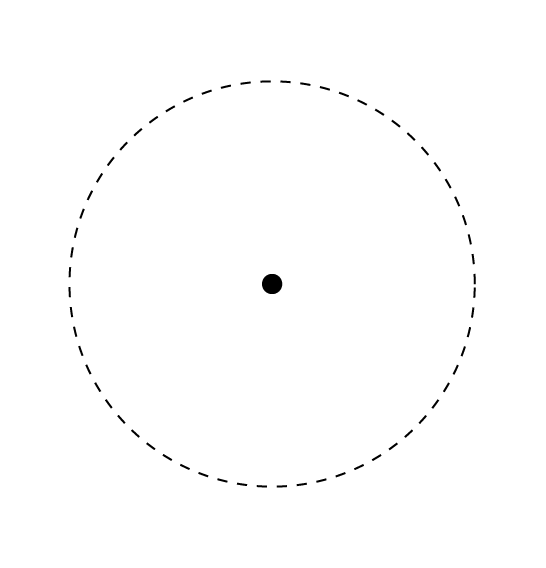Interestingly enough, the number “one” wasn’t considered a “number” according to many groups like the Pythagoreans (around 500 B.C). One was the progenitor of all numbers, it was the source by which all numbers came into being. It represented unity, but not any kind of unity that was conceivable in this world.
Confused? Think about it, a single point does not exist anywhere in nature. Even a dot on a sheet of paper is not a point, because upon magnification, we find a circle that has a radius and circumference so therefore it doesn’t constitute an actual point without sides, length, height and depth. Because of this otherworldly connotation of one, it had divine qualities attached to it. “Just as unity is in every number / thus God the one is everywhere in everything” – Angelus Silesius (The Book of Symbols: Reflections on Archetypal Images, by Archive for Research in Archetypal Symbolism and ARAS, 710)
The shape that is best suited to represent the number one is a circle. A shape without sides or other dimensions, the center of the circle becomes emblematic of the invisible point that we know as “one”. Like a stone dropped into a pond, the single point radiates outward into endless circles. The circle can represent:
- God
- Unity
- Heaven
- Eternity (eternal time)
- Covenants (circumcision, arrangement of people or objects in a circle)
- Blood (the sacrament cup, properties of liquid)
- The Spirit (via the symbolism of the Liahona)
- A complete cycle (orbit, seasons, return, etc.)
- Water (water pulls itself into a spherical shape, i.e., drops)
- Bounds or Perimeter (Proverbs 8:27 When he prepared the heavens, I was there: when he set a compass upon the face of the depth:)
- Space
- The Sun
- The Moon
Since a compass is the tool used to create circles, the compass may also be associated with some of the same ideas.
When you blow a bubble it forms into a circle, objects in space gravitate toward one another in circular, spherical forms. Everything seeks unity (A Beginner’s Guide to Constructing the Universe, by Michael Schneider – 1st ed., 20) according to natural law and as we seek unity of God, we too are trying to ‘complete the circle’ by returning back home to his presence.
We see the circle used in scripture:
- Isaiah 40:22, It is he that sitteth upon the circle of the earth, and the inhabitants thereof are as grasshoppers; that stretcheth out the heavens as a curtain, and spreadeth them out as a tent to dwell in:
- Doctrine and Covenants 137:2, I saw the transcendent beauty of the gate through which the heirs of that kingdom will enter, which was like unto circling flames of fire;
- The laver of water in the ancient temple was circular: 2 Chronicles 4:2 Also he made a molten sea of ten cubits from brim to brim, round in compass.
- 2 Nephi 5:12, And I, Nephi, had also brought the records which were engraven upon the plates of brass; and also the ball, or compass, which was prepared for my father by the hand of the Lord, according to that which is written.
- Alma 7:20, …he cannot walk in crooked paths; neither doth he vary from that which he hath said; neither hath he a shadow of turning from the right to the left, or from that which is right to that which is wrong; therefore, his course is one eternal round.
- Think of the circumcisions that were performed on male Israelites. The circumcisions was a sign of a covenant to the circumcised individual along with a strong veiled reference to the influence of the covenants on the seed or posterity of that individual as well.
- Bible Dictionary: Gilgal. A wheel or circle of stones. (1) The place near Jericho at which the Israelite camp was made on the first night after crossing the Jordan (Josh. 4:19; 5:10; 10). Here the 12 stones from the Jordan were set up as a monument to the parting of the Jordan River by the power of God.
We also see the circle used in modern LDS temples. Most often, the circle is combined with other shapes that provide a depth of meaning. Possibly one of the most common arrangements utilizing the circle on modern temples is the circle within the square.
The two shapes, the circle or compass, and square, bear strong ties to the architect’s compass and the builder’s square (The Day Star: Reading Sacred Architecture, Alphabet and Archetypes by Val Brinkerhoff, 55), which are very old archetypal elements used in scripture and by various groups throughout history. The Masonic square and compass are a familiar symbol, but they’ve been around far longer than Masonry.
Symbols mean different things depending on the context. Indeed, context is everything since symbols are merely vehicles of ideas. Simply archetypal symbols all have their beginnings with God and have pure meanings. Unfortunately, many of the most sacred symbols have been borrowed by evil men and the adversary to promote their self-serving messages. It is critical to note that the adversary can only speak through symbols that already exist.
If I take the symbols L-I-E alone, I can convey an idea, a word that is defined as: “a false statement made with deliberate intent to deceive”. The word connotes a negative idea, but if I place the same symbols within other symbols like this: B-E-L-I-E-V-E, then a whole new meaning appears. The word believe means “to have confidence in the truth, the existence, or the reliability of something.” It would be foolish to discard the word ‘believe’ just because the word ‘lie’ sits right in the center of it.
In the same way, it is important to understand the context that the symbol is presented; see this article for another example.
The circle inside of a square is a curious configuration due to the many different things it can mean. The alphabet of symbols and the context in which they are framed help us to understand their meaning. To me, the circle within the square is probably the most perfect symbol of a temple.
The circle represents that which is not of this world or that which cannot be comprehended within this sphere. The square is representative of the earth, the flesh, this world and that which is measurable. So if we combine these ideas, a possible meaning of the circle within the square is a representation of a place where the eternal can be comprehended within the bounds of the physical. The temple is a place of symbols in this world, where eternal truths are meant to be taught, not by man, but by the Spirit of the Lord through symbols.
We see the circle appearing again and again in many other contexts. One need only visit a local temple or browse some of Val Brinkerhoff’s fantastic photos of architectural symbolism.
Updated: February 15, 2011







1 Comment
nice compass